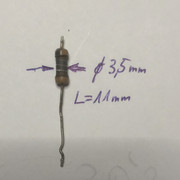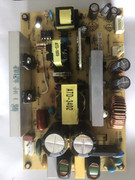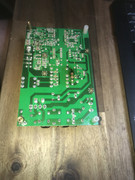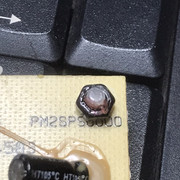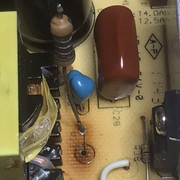|
|
Post by tjmotter on May 4, 2022 15:53:07 GMT -5
I recently took on a project that grew in scope and I learned some interesting things about newer Onkyo models that I thought I would share.
Background: I bought an Onkyo RZ820 off eBay (their high end model from this series) that was missing an HDMI board and a pre-amp board. I had a dead RZ820 HDMI board lying around that I thought I could fix so I started to do some research to see if I could find the pre-amp board. The unit arrived before I had ordered anything and I was very surprised and disappointed to find that the previous owner had removed the screws that held the heatsink in place. Couple this with rough shipping from FedEx and as the attached picture shows, the main board was broken in half.
During my research I realized that the NR575/NR676/HT-R997/RZ620/NR777 and RZ720 all used many of the same Printed Circuit Board (PCB's) but each model was populated differently to provide features (like higher end power transistors, Pre-Out connectors, Zone3 etc). Of course, the front panel was completely different and the RZ820 is a taller unit so Onkyo created a custom DAC filter board (the riser board at the rear of the unit) and they upgraded the transformer to match with the higher power transistors. It soon became obvious that Onkyo was in a cost cutting mode and were trying to leverage (essentially) one design to create multiple different models. Interestingly, all of these models use the same firmware package from Onkyo so the only logical difference between them is the "personality module" (small EEPROM) with unit specific configuration info.
With this in mind, I bought a dead NR676 off eBay but when it arrived, I found that I had an NR686 with a blown amplifier circuit so I ordered another NR676 so that I would have the parts I needed. When I took the NR686 apart, I quickly realized that it had the same Main board, the same power supply, the same HDMI board and the same speaker-out PCB's as the RZ820 but it was too late for me to cancel the order for the NR676. Again, they had populated the boards differently but all of the traces were laid out to accommodate multiple models. Later, when the NR676 arrived (some child had inserted a screwdriver into each HDMI port and broke all of their contacts) I compared the 3 systems. I quickly repaired the NR686, upgraded the firmware and since it was in pretty good shape, I decided against using it as my donor but I was surprised when I compared it to the NR676 and found that they were electrically identical. Literally, the only physical difference in the NR676 and the NR686 was the printing of the model on the front/rear of the unit. Upon further investigation, I realized that the only difference between the two was the firmware that was loaded onto the NR686 to provide some new features (Google support for example).
Deciding to use the NR676 as my "donor", I was able to repopulate the board into an RZ820 configuration by moving a ton of components from the broken board to the NR676 board. I was then able to rebuild my RZ820 HDMI board (Main CPU blown, Video Processor blown, Network Processor blown and both HDMI controllers blown). While doing this, I systematically disassembled a dead RZ810 HDMI board (bad HDMI chips) and used the good parts to rebuild the RZ820. I did have to buy a couple of new HDMI parts out of China but after all this work I now have a fully functional RZ820 and a fully functional NR686. Since the NR676 HDMI board seemed good (except for the broken HDMI ports) I replaced all of those ports with parts from the RZ810 and then moved the Zone 3/Fan/RS232 circuitry from the RZ810 over to the NR676 board. I then copied the personality module from the RZ820 to the NR676 board and have a good working spare RZ820 HDMI board as well.
I wasn't sure this was possible but thought it might help others to know that parts from other Onkyo units may be able to be converted if necessary.
HTH Todd
Attachments:
|
|
|
|
Post by mastertech on May 4, 2022 20:25:14 GMT -5
That is some nice information.
 |
|
Deleted
Deleted Member
Posts: 0
|
Post by Deleted on May 5, 2022 4:12:10 GMT -5
This is good to know when buying faulty amps with a view to carrying out repairs. Earlier Onkyo models didn't have this level of interchangeability from what I've seen.
Most of my repairs have been on Pioneer units because they are less problematic with the DSP firmware side of things but I also noticed Onkyo went into cost cutting mode as early as the TX-NR636.
It started with the output transistors... the TX-NR616 has 2SC5242/2SA1962 rated at 230V 15A but the TX-NR636 has 2SC5198/2SA1941 rated at 140V 10A. The earlier model also had a main heatsink made from solid aluminum where the later had a fabricated one.
Despite this apparent downgrade to the power amp, both units are similarly rated on output power. What I have noticed is the 636 is a model that regularly appears for sale with blown output and driver stages, where the earlier ones are nearly always HDMI or DSP issues.
I've not worked on newer (post Onkyo takeover) Pioneer units yet but I guess it will be a similar story there too, since they are likely to be badged Onkyos now.
|
|
Deleted
Deleted Member
Posts: 0
|
Post by Deleted on May 5, 2022 5:44:50 GMT -5
This thread got me looking at the service manuals for some of the newer high end model Onkyos to see if the absorption of Pioneer had any effect on their designs.
The RZ1100 and 3100 models have both dropped their old power hungry bipolar transistor output stage in favour of Pioneer's more efficient Class D mosfet design. They even use exactly the same output devices as the older Pioneer models as far back as the SC-LX85/86 (SC-57/68 in the US).
Progress of sorts I guess?!
|
|
|
|
Post by tibimakai on May 5, 2022 10:00:16 GMT -5
Wow, that board is super bad. And I thought that my RZ810 main/bottom board crack was bad.
That must of been a long process, to transplant all those components.
Great job Todd!!
|
|
|
|
Post by tjmotter on May 8, 2022 19:51:02 GMT -5
It started with the output transistors... the TX-NR616 has 2SC5242/2SA1962 rated at 230V 15A but the TX-NR636 has 2SC5198/2SA1941 rated at 140V 10A. The earlier model also had a main heatsink made from solid aluminum where the later had a fabricated one. Despite this apparent downgrade to the power amp, both units are similarly rated on output power. What I have noticed is the 636 is a model that regularly appears for sale with blown output and driver stages, where the earlier ones are nearly always HDMI or DSP issues I don't disagree that Onkyo has moved to lower rated parts both in the design themselves but also in the infrastructure elements like heatsinks. Even simple and relatively cheap parts like fans were standard in earlier models but are noticeably lacking in the newer models. The RZ820 has a fan (because it needs one) but the NR676 and NR686 don't even though all of the contacts are there for it and it requires less than $3.00 in electronics to enable it.
FWIW, I rarely see output transistors as the cause of failures. While I have seen 1 or 2 where the power transistor seemed to blow first, the primary cause of failure that I see is capacitors. In these latest designs, Onkyo uses 3 47uF 50V (audio) capacitors in the pre-amp stage on every channel. The issue is that these caps are rated at only 85 degrees and that section of the amp gets really hot coupled with the fact that these capacitors sit in pretty important parts of the design. These 47uF capacitors are almost always the cause of failure so one of the first things I do with any system is remove all of these capacitors and upgrade them to high quality Nichicon 47uF 50V capacitors rated at 105 degrees. I have never seen a receiver fail again after doing this. If it helps, these are the capacitors I use:
HTH Todd
|
|
Deleted
Deleted Member
Posts: 0
|
Post by Deleted on May 9, 2022 3:22:23 GMT -5
I agree the lower rated transistors aren't likely to cause the amp to fail but it's always nice to have parts that are higher rated for reliability.
I've seen the vented caps in the driver stages of a couple of 636s I've repaired but wasn't sure if they were the cause or an effect. I also replace them with 105deg parts from reputable manufacturers.
Onkyos certainly seem to run a lot hotter than their Pioneer counterparts and the fans don't seem to kick in soon enough on the models that do have them fitted. The class D Pioneers are far better in this respect and run much cooler and are far more efficient.
The older Onkyo designs like the TX-NR906 are impressive engineering with 28 output devices and 3 power transformers but the fact Onkyo have adopted Pioneer's Class D technology for the flagship models shows things have moved on.
|
|
|
|
Post by tibimakai on May 11, 2022 10:49:36 GMT -5
I also noticed, that the final transistors always could use some screw tightening. They are never tight.
|
|





